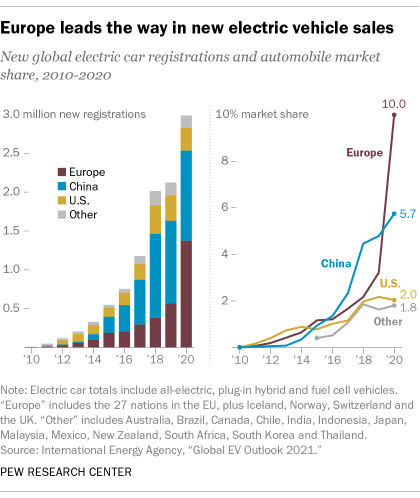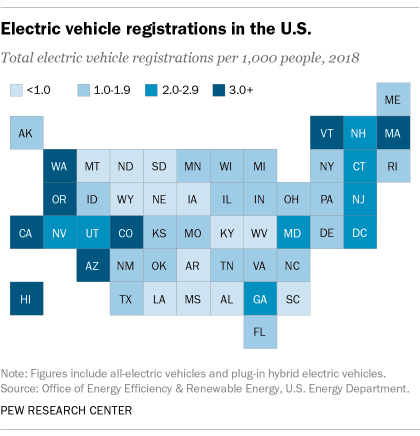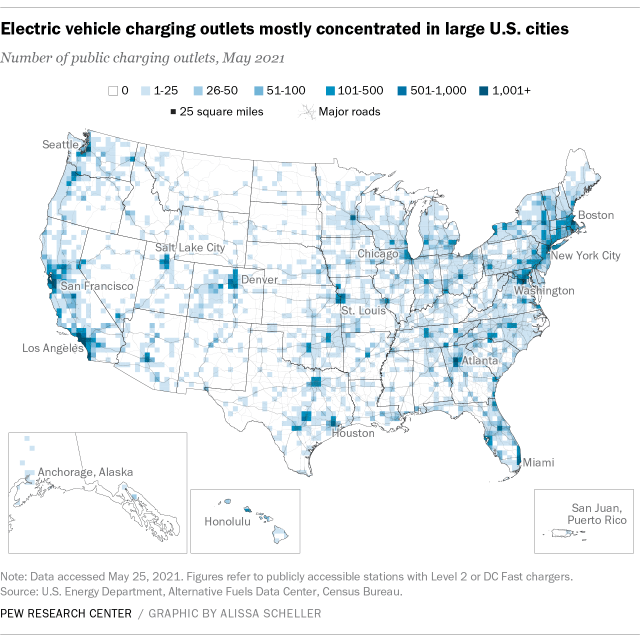A small but significant share of car owners in the United States have traded filling up for plugging in, and many more are thinking of joining them. In a recent Pew Research Center survey, 7{c9ada2945935efae6c394ba146a2811ce1f3bfd992f6399f3fbbb16c76505588} of U.S. adults said they currently have an electric or hybrid vehicle, and 39{c9ada2945935efae6c394ba146a2811ce1f3bfd992f6399f3fbbb16c76505588} said they were very or somewhat likely to seriously consider buying an electric vehicle the next time they’re in the market for new wheels.
Outside of a few major metropolitan areas, electric vehicles (EVs) aren’t all that common in the U.S. While their numbers have grown rapidly in absolute terms in recent years, that’s from a relatively small base.

As of 2020, nearly 1.8 million EVs were registered in the U.S., more than three times as many as in 2016, according to the International Energy Agency (IEA). They come in three broad categories. All-electric vehicles (also called battery-electric vehicles) have been the fastest-growing category: The total number of such vehicles registered in the U.S. has soared from fewer than 300,000 in 2016 to more than 1.1 million last year. Consumers have purchased the other two types of EVs, plug-in hybrid vehicles and fuel cell vehicles, at lower rates.
With electric vehicles (EVs) slowly but steadily gaining in popularity in the U.S., we wanted to find out just how widespread they are, and how their growth here compares with that in other parts of the world.
Our main data source was the International Energy Agency, an affiliate of the Organization for Economic Cooperation and Development. We also used data on EVs and charging stations from the U.S. Energy Department, specifically the Office of Energy Efficiency & Renewable Energy and its Alternative Fuels Data Center. This dataset is updated frequently; we accessed it on May 25, 2021.
Other sources included the Census Bureau, for data on vehicle registrations and information on electric cars a century ago, and the Idaho National Laboratory for information on the past, present and possible future of electric cars.
Although the details can be a bit confusing, these days electric vehicles (EVs) come in three basic types. “All-electric vehicles,” sometimes called “battery electric vehicles,” run entirely on the electricity stored in their onboard battery packs. “Plug-in hybrid electric vehicles” have a small internal-combustion engine along with the battery pack; should the batteries run down, the gasoline engine can take over. With both those types, users recharge the batteries by plugging their cars into special charging stations. The third type, “fuel cell electric vehicles,” has onboard fuel cells that generate electricity from compressed hydrogen to power the motor. But there are far fewer fuel cell vehicles than the other two varieties.
All of these are distinct from “hybrid electric vehicles,” in which a relatively small electric motor supplements an internal combustion engine. This was a common setup in the first generation of mass-market “electric cars,” but because these cars don’t have rechargeable batteries and their electric motors are too small to propel the car on their own, they’re not generally counted as EVs today.
But the U.S. represents only about 17{c9ada2945935efae6c394ba146a2811ce1f3bfd992f6399f3fbbb16c76505588} of the world’s total stock of 10.2 million EVs, according to IEA data. China has 44{c9ada2945935efae6c394ba146a2811ce1f3bfd992f6399f3fbbb16c76505588} of all the EVs in the world (more than 4.5 million), and the nearly 3.2 million in Europe account for about 31{c9ada2945935efae6c394ba146a2811ce1f3bfd992f6399f3fbbb16c76505588}.

The fastest growth in EV sales has been in Europe: a compound annual growth rate of 60{c9ada2945935efae6c394ba146a2811ce1f3bfd992f6399f3fbbb16c76505588} from 2016 to 2020, compared with increases of 36{c9ada2945935efae6c394ba146a2811ce1f3bfd992f6399f3fbbb16c76505588} in China and 17{c9ada2945935efae6c394ba146a2811ce1f3bfd992f6399f3fbbb16c76505588} in the U.S.

Last year, nearly three-quarters of all cars sold in Norway and more than half of those sold in Iceland were electric – by far the highest market shares for EVs in any of the 31 countries for which IEA has collected data. In 10 other European countries, between a tenth and a third of all new-car sales last year were electric.
By contrast, sales have slowed in the U.S. in the past few years, largely due to the declining popularity of plug-in hybrids and the phaseout of federal tax credits on some of the most popular models. Last year, about 64,300 plug-in hybrids were sold, about half as many as in 2018, according to the IEA. Meanwhile, about 231,000 all-electric vehicles were sold in 2020, down 3.2{c9ada2945935efae6c394ba146a2811ce1f3bfd992f6399f3fbbb16c76505588} from 2018. In each of the past three years, EVs accounted for about 2{c9ada2945935efae6c394ba146a2811ce1f3bfd992f6399f3fbbb16c76505588} of the U.S. new-car market. The COVID-19 pandemic may have affected vehicle sales of all types in 2020, making comparisons difficult.
California has by far the highest share of EVs of any U.S. state – which is to be expected, given that for decades the state has required carmakers to build EVs and has used an array of rebates and other incentives to encourage Californians to buy them. As of 2018, the most recent year for which federal data is available, California had about 12 EV registrations per 1,000 people; the next-highest state, Hawaii, had roughly six registrations per 1,000 people.
To support all those EVs, California also has led in building out networks of charging stations. Of the more than 42,000 publicly accessible charging stations in the U.S. as of May 25, 2021 (containing more than 102,000 individual outlets) across the U.S., nearly a third (30.8{c9ada2945935efae6c394ba146a2811ce1f3bfd992f6399f3fbbb16c76505588}) are in California, according to Pew Research Center’s analysis of Energy Department data. For comparison, there are an estimated 145,000 to 150,000 gasoline retailers in the U.S.
Relative to the size of its vehicle fleet, though, Washington, D.C., may be the most convenient place in the U.S. to drive an EV. The 237 charging stations in the federal district have a total of 630 outlets, or one for every 487 privately owned cars and trucks on D.C. roads. (Vermont and, yes, California place second and third; the national average is one outlet for every 2,570 private and commercially owned cars and trucks.)

Nationwide, the number of publicly available charging stations has more than tripled since 2015, when there were fewer than 32,000 throughout the country, according to IEA data. The agency projects that number to grow dramatically by the end of the decade, to between 800,000 and 1.7 million, depending on which public policies are adopted. (President Joe Biden’s infrastructure proposal includes a national network of 500,000 charging stations; in the Pew Research Center poll, 62{c9ada2945935efae6c394ba146a2811ce1f3bfd992f6399f3fbbb16c76505588} of Americans said they favored such a plan.)
Electric cars weren’t always such a small percentage of the U.S. market. Over a century ago, while the auto business was still in the learner’s-permit stage, electricity competed fiercely with steam and gasoline to be the new industry’s dominant power source. In 1900, in fact, more than a third of all cars built in the U.S. were electric, according to a Census Bureau report from that time. (True, that was 1,575 cars out of a total of 4,192, but still.)
Within a couple of decades, however, several developments would lead to the dominance of the gas-powered internal-combustion engine. Among them were public desire for longer-range vehicles; electric starters replacing cumbersome and hazardous hand-cranks; lower gasoline prices; and assembly line mass production. By 1935, electric vehicles had all but disappeared.




More Stories
Auto Forex Trading Software – Come Out a Winner With the Auto Forex Trading Software
Sick Cars – Millions May Be on the Road
Important Steps For Selecting An Auto Repair Shop